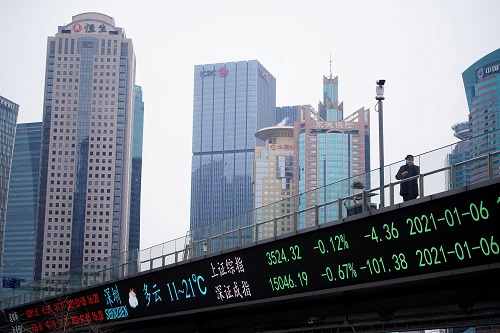Crudeoil trading range for the day is 6372-6568 -Kedia Advisory

Follow us Now on Telegram ! Get daily 10 - 12 important updates on Business, Finance and Investment. Join our Telegram Channel
Gold
Gold exhibited a robust performance, settling up by 0.94% at 66,023 as the dollar index extended losses to 102.5, reaching its lowest level since mid-January. The weakening dollar was fueled by the latest jobs report, which indicated signs of a cooling labor market. Despite the February payrolls figure surpassing forecasts, revisions to job gains in January and December were sharply lower, and the unexpected increase in the unemployment rate, along with slower-than-anticipated wage growth, reinforced expectations of an imminent interest rate cut by the Federal Reserve. Investors currently assign a nearly 57% probability of a 25bps reduction in the fed funds rate in June. Federal Reserve Chair Powell, while emphasizing the need for confidence in sustainable inflation at 2% before rate cuts, acknowledged the proximity of such a move. The gold market also saw significant activity from central banks, with the Central Bank of Turkey being the largest buyer, increasing official gold holdings by 12.2t. The People's Bank of China added 10t for the 15th consecutive month, bringing total gold holdings to 2,245t, nearly 300t higher than in October 2022. The Reserve Bank of India recorded its first monthly increase in gold reserves since October 2023, adding nearly 9t, with total holdings now at 812t. From a technical perspective, the gold market witnessed fresh buying with a 2.73% increase in open interest, settling at 17,862. With prices up by 617 rupees, gold finds support at 65,505, potentially testing 64,990 if breached. On the upside, resistance is likely at 66,445, and a move above could see prices testing 66,870.
Trading Ideas:
* Gold trading range for the day is 64990-66870.
* Gold rose to cross 66000 as dollar fell lowest level since mid-January.
* The labour market is showing signs of cooling, reinforcing bets the Fed is close to starting cutting interest rates.
* The February payrolls figure came above forecasts but job gains in both January and December were revised sharply lower
Silver
Silver prices experienced a slight decline of -0.07%, settling at 74262, driven by profit booking following the release of positive US economic data. The US economy added 275K jobs in February, surpassing expectations of 200K and outperforming the revised figure of 229K in January. Federal Reserve Chair Jerome Powell indicated that while the central bank plans to cut interest rates this year, it requires further evidence of inflation falling to the 2% target. Minneapolis Fed President Neel Kashkari expressed a dovish stance, revealing plans for two interest-rate cuts in 2024 but suggesting a potential adjustment based on incoming stronger macro data. The Automatic Data Processing (ADP) reported a rise of 140K in private-sector employment in February, slightly below the expected 150K, with wages increasing at the slowest pace in 2-1/2 years. The stable number of Americans filing new unemployment claims provided the Federal Reserve with room to wait before implementing interest rate cuts. Despite a widening trade deficit in January due to increased imports of computers, semiconductors, and vehicles, the first-quarter economic growth is anticipated to slow only marginally, supported by a resilient labor market boosting consumer spending. From a technical perspective, the silver market is currently undergoing long liquidation, marked by a -1.1% drop in open interest, settling at 22162. Silver has support at 73940, and a breach below this level could test 73620. On the upside, resistance is anticipated at 74710, with a move above potentially leading to prices testing 75160.
Trading Ideas:
* Silver trading range for the day is 73620-75160.
* Silver dropped on profit booking after US economy added 275K jobs in February 2024
* Federal Reserve Chair Jerome Powell told US lawmakers that the central bank will cut interest rates this year.
* Fed’s Kashkari said that he had pencilled in two interest-rate cuts in 2024 and added that he may reduce the number of cuts
Crude oil
Crude oil faced a decline of -1.46%, settling at 64.59, predominantly influenced by increased oil production from non-OPEC+ countries, with the United States playing a pivotal role. Lingering concerns over China's economic growth further contributed to the challenges confronting the oil market. However, Federal Reserve Chair Jerome Powell's indication of potential interest rate adjustments offered a glimmer of hope, bolstering the outlook for global growth and, consequently, energy demand. A positive development for the oil market was TC Energy Corp.'s confirmation of the Keystone pipeline's integrity after a brief halt, alleviating immediate supply concerns. Additionally, China's robust crude oil imports in the first two months of 2024, increasing by 5.1% year-on-year, indicated heightened demand as refiners ramped up purchases to meet fuel demands during the Lunar New Year holiday. In the U.S., the Energy Information Administration (EIA) reported a rise in crude inventories by 1.4 million barrels to 448.5 million barrels in the week ended March 1. However, gasoline and distillate inventories saw declines, reflecting a mixed picture in the domestic market. From a technical standpoint, the crude oil market is currently under fresh selling pressure, witnessing a substantial 63.86% increase in open interest, settling at 5,555. With prices down by -96 rupees, crude oil finds support at 6,415, potentially testing 6,372 if breached. On the upside, resistance is likely at 6,513, and a move above could see prices testing 6,568.
Trading Ideas:
* Crudeoil trading range for the day is 6372-6568.
* Crude oil dropped amid increased oil production from non-OPEC+ countries
* Lingering worries over China's economic growth further compounded the challenges facing the oil market.
* China's crude oil imports in the first two months of 2024 rose 5.1% from a year earlier
Natural gas
Natural gas prices faced a decline of -1.49%, settling at 151.7, primarily influenced by warmer-than-normal weather conditions that dampened heating demand. The abundance of inventories further contributed to the downward pressure on prices. Notably, the flow of natural gas to liquefied natural gas (LNG) export plants remained low due to an ongoing outage at Freeport LNG's facility in Texas. Despite a recent drop in output and forecasts for cooler weather, natural gas prices experienced a decline to a 3.5-year low in February. The U.S. Energy Information Administration (EIA) reported a withdrawal of 40 billion cubic feet (bcf) from storage during the week ended March 1, aligning with analysts' expectations. This withdrawal was less than the 72 bcf decrease observed in the same week last year and below the five-year average decline of 93 bcf for this period. Financial firm LSEG noted a decline in gas output in the Lower 48 to an average of 100.1 billion cubic feet per day (bcfd) in March, down from 104.1 bcfd in February. Daily output was on track to decrease by approximately 4.8 bcfd over the last month, reaching a preliminary seven-week low of 99.0 bcfd. From a technical standpoint, the natural gas market is undergoing long liquidation, with a -2.86% drop in open interest, settling at 61851. Natural gas has support at 147.5, and a breach below this level could test 143.4. On the upside, resistance is anticipated at 154.4, and a move above could lead to prices testing 157.2.
Trading Ideas:
* Naturalgas trading range for the day is 143.4-157.2.
* Natural gas slipped as warmer-than-normal weather slowed heating demand
* The amount of gas flowing to LNG export plants remained low
* EIA said utilities pulled 40 bcf of gas out of storage during the week ended March 1.
Copper
Copper experienced a modest decline of -0.52%, settling at 731.6, driven by an 11.3% increase in copper inventories in warehouses monitored by the Shanghai Futures Exchange. Despite this, the downside was limited as LME-registered warehouse stocks decreased by 32% this year to 114,075 tons. The global copper market faced mixed signals, with China announcing a 5% growth target for 2024 at a parliamentary meeting, disappointing some investors anticipating more extensive stimulus measures. China's manufacturing sector also witnessed its fifth consecutive month of contraction in February, prompting calls for increased stimulus to stabilize growth. In contrast, China's unwrought copper imports in the first two months of 2024 rose by 2.6% from the previous year, indicating improving demand. Arrivals of unwrought copper and products reached 902,000 metric tons in January and February, up from 879,000 tons in the same period a year earlier. Additionally, imports of copper concentrate increased by 0.6% to 4.66 million tons during the first two months of the year. China's major copper smelters are set to convene in Beijing to discuss measures, including potential production cuts, to counter the significant drop in ore processing fees, which have hit their lowest levels in years. Technically, the copper market observed long liquidation, with a -3.59% drop in open interest, settling at 4,103, while prices experienced a decline of -3.85 rupees. Currently, copper finds support at 727.6, potentially testing 723.5 if breached. On the upside, resistance is likely at 738.7, and a move above could see prices testing 745.7.
Trading Ideas:
* Copper trading range for the day is 723.5-745.7.
* Copper dropped as Shanghai warehouse stocks up 11.5%
* However, downside seen limited as LME stocks have decreased by 32% this year
* China's announcement of a 5% growth target for 2024 at a recent parliament meeting disappointed some investors.
Zinc
Zinc prices experienced a marginal decline of -0.16%, settling at 221.05, influenced by an 11.3% increase in zinc inventories in Shanghai Futures Exchange-monitored warehouses since last Friday. However, the downside was limited due to ongoing supply concerns, notably the Seokpo smelter in South Korea cutting its output by a fifth. This substantial reduction by the world's sixth-largest smelter raises the potential of narrowing the expected market surplus of 300,000 tons or even pushing it into a deficit. Zinc also found support from hopes of increased demand, as recent remarks from Fed policymakers and softer-than-anticipated labor market data from the US solidified expectations of interest rate reductions this year. On the flip side, uncertainty regarding the economic recovery in China, the leading consumer, and elevated inventories at LME warehouses above 275,000 tons exerted downward pressure on the commodity. The International Lead and Zinc Study Group (ILZSG) reported that the global zinc market deficit increased to 62,600 metric tons in December 2023 from a deficit of 53,500 tons in November. However, the full-year 2023 data showed a surplus of 204,000 tons, compared to a deficit of 73,000 tons in 2022. From a technical standpoint, the zinc market is undergoing long liquidation, evidenced by a -4.94% drop in open interest, settling at 3846. Zinc has support at 219.5, and a breach below this level could test 217.8. On the upside, resistance is expected at 223.1, with a move above potentially leading to prices testing 225.
Trading Ideas:
* Zinc trading range for the day is 217.8-225.
* Zinc dropped as Shanghai warehouse zinc stocks up 11.3%
* However, downside seen limited as output cut at a zinc smelter in South Korea caused supply uncertainty.
* Global zinc market deficit expands in December – ILZSG
Aluminium
Aluminium prices dipped by -0.27%, settling at 202.55, following China's announcement of a 5% growth target for 2024 during a recent parliamentary meeting. Some investors were disappointed as they had hoped for more extensive stimulus measures. The government also set a fiscal deficit-to-GDP ratio of 3% for 2023, below the revised 3.8% target for the same year. Fiscal spending is projected to rise by 4%, a decrease from last year's target of 5.6%, and fiscal revenue is expected to increase by 3.3%, falling short of last year's target of 6.7%. However, the downside was limited by concerns over potential Russian aluminum bans by the EU. The EU is contemplating sanctions on Russian aluminum, and there are expectations of an upcoming proposal for import bans. This move could result in a 500,000-ton shortfall in Europe, posing a challenge for Middle Eastern suppliers attempting to quickly substitute Russian metal. According to data from the World Bureau of Metal Statistics (WBMS), global primary aluminum production was 5.9719 million tons in December 2023, with consumption at 5.8364 million tons and a supply surplus of 135,500 tons. In January, global primary aluminum production slightly decreased by 0.05% compared to the previous month but rose by 2.4% compared to the same month a year ago, according to the IAI. Technically, the aluminum market is undergoing long liquidation, with a -1.22% drop in open interest, settling at 4355. Aluminium has support at 201.4, and a breach below this level could test 200.1. On the upside, resistance is expected at 204.3, with a move above potentially leading to prices testing 205.9.
Trading Ideas:
* Aluminium trading range for the day is 200.1-205.9.
* Aluminium dropped as China's 5% growth target for 2024 disappointed investors
* However, downside seen limited driven by the looming threat of Russian aluminum bans by the EU.
* Global primary aluminum production grows in Jan y-o-y - IAI
Cotton
Cotton Candy prices showed resilience, settling with a marginal gain of 0.03% at 62,700 after an initial surge driven by the World Agricultural Supply and Demand Estimates (WASDE) report indicating lower ending stocks for the 2023/24 U.S. cotton balance sheet. The report highlighted increased exports and reduced mill use. A cold spell in China affecting crop cycles and reduced acreage in the U.S. contributed to a global cotton shortage, supporting prices. However, profit booking ensued, tempering the upward momentum. The Southern India Mills’ Association (SIMA) advised textile mills to avoid panic buying as cotton prices rise, anticipating a global supply increase post-July. The U.S. Department of Agriculture (USDA) reported a decrease in net sales for 2023/2024, down 69% from the previous week and 83% from the prior 4-week average. The February WASDE report showed a 355,000 bales reduction in the projected world cotton production for 2023/24, with lower ending stocks and production. Indian cotton exports surged in February to the highest level in two years, reaching 400,000 bales, as global prices made Indian cotton attractive for Asian buyers. India's total cotton production is expected to fall 7.7% to 29.41 million bales in 2023/24, the lowest since 2007/08. Technically, the cotton market witnessed short covering with a -0.82% drop in open interest, settling at 364. Prices increased by 20 rupees, with support at 62,500 and potential testing of 62,300 if breached. Resistance is likely at 63,000, and a move above could see prices testing 63,300. Traders should monitor these levels amidst evolving global supply dynamics and demand patterns to make informed decisions in the Cotton Candy market.
Trading Ideas:
* Cottoncandy trading range for the day is 62300-63300.
* Cotton dropped on profit booking after prices gained as US has lower ending stocks
* Support also seen as severe cold in China has affected the crop
* SIMA urges textile mills to avoid panic buying as cotton prices rise, global supply expected to increase post July.
* In Rajkot, a major spot market, the price ended at 29165.45 Rupees dropped by -0.35 percent.
Turmeric
Turmeric prices surged by 4.03%, settling at 18,086, bolstered by reduced supplies in the spot market. However, the upside appears limited as buying activities slowed in anticipation of stock releases ahead of the commencement of new crops. The delayed harvesting of the new crop and tighter ending stocks are expected to maintain positive market sentiments for turmeric in the near term. Despite improved crop conditions due to favorable weather, concerns arise from expectations of a 20–25% decline in turmeric seeding this year, particularly in areas like Maharashtra, Tamil Nadu, Andhra Pradesh, and Telangana, as farmers shift priorities. Turmeric exports during Apr-Dec 2023 dropped by 2.27% at 121,171.01 tonnes compared to the same period in 2022. However, December 2023 showed a rise of 21.47% compared to November 2023, despite a 13.41% drop compared to December 2022. In the Nizamabad spot market, the price ended at 15,414.35 Rupees, dropping by -0.68%. From a technical perspective, the turmeric market is under fresh buying, witnessing a 0.93% increase in open interest, settling at 15,675, with prices up by 700 rupees. Support is at 17,560, potentially testing 17,036 if breached, while resistance is likely at 18,518, and a move above could see prices testing 18,952. Traders should monitor these levels considering evolving supply dynamics and crop conditions to make informed decisions in the turmeric market.
Trading Ideas:
* Turmeric trading range for the day is 17036-18952.
* Turmeric prices gained supported by reduced supplies in the spot market.
* However, upside seen limited as buying activities has been slower in expectation of new crops.
* Export has been slow down in recent months and expected to increase in wake of series of festivals ahead.
* In Nizamabad, a major spot market, the price ended at 15414.35 Rupees dropped by -0.68 percent.
Jeera
Jeera prices surged by 2.35%, settling at 25280, driven by emerging weather risks in Rajasthan and Gujarat that could adversely affect yields. The market, however, faced limitations on the upside as jeera acreage reached a four-year high in the current rabi season. Farmers in key producing states of Gujarat and Rajasthan expanded cultivation, responding to record prices in the previous marketing season, showcasing a strong correlation between market prices and acreage. In Gujarat, jeera cultivation covers a substantial 5.60 lakh hectares, marking a significant 160% increase from the previous year. This surpasses the normal jeera acreage of 3.5 lakh hectares in the state. Rajasthan witnessed a 25% increase in jeera cultivation, reaching 6.90 lakh hectares compared to 5.50 lakh hectares in the previous year. Global demand for Indian jeera declined as buyers preferred other destinations like Syria and Turkey due to higher prices in India. While India anticipates a potentially bumper crop, other major jeera-producing countries like China, Egypt, and Syria expect higher yields, impacting the global market. Jeera exports during Apr-Dec 2023 dropped by 29.95% at 96,701.43 tonnes compared to the same period in 2022. However, December 2023 showed a month-on-month rise of 51.05%. Technically, the market is under fresh buying, with an 8.01% increase in open interest, settling at 2589. Jeera has support at 24830, and a breach below this level could test 24360. On the upside, resistance is expected at 25630, with a move above potentially leading to prices testing 25960.
Trading Ideas:
* Jeera trading range for the day is 24360-25960.
* Jeera gained in wake of emerging weather risk in Rajasthan and Gujarat may affect the yield.
* However, upside seen limited as jeera acreage hits a four-year high in the current rabi season.
* Stockists are showing interest in buying on recent downfall in prices triggering short covering.
* In Unjha, a major spot market, the price ended at 28109.6 Rupees gained by 0.63 percent.
Views express by all participants are for information & academic purpose only. Kindly read disclaimer before referring below views. Click Here For Disclaimer












 320-x-100_uti_gold.jpg" alt="Advertisement">
320-x-100_uti_gold.jpg" alt="Advertisement">












